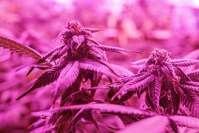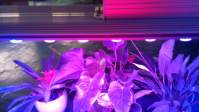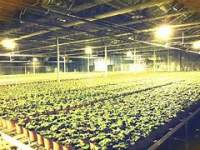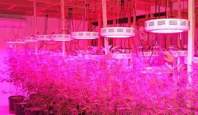LED plant grow lights are one of the most promising supplementary lighting types for indoor planting. Let us understand this in more detail, because this LED plant grow light has many advantages compared with other traditional plant lights, and because it is indoor planting A new stage of agricultural development.
Plant growth process: From simple molecules, a huge organic chain is constructed to form the plant itself. For any process, energy is needed, and in real life conditions, plants use sunlight to obtain energy. A photon enters the leaf and initiates a biochemical reaction. The result is an increase in weight-roots, stems, leaves and fruits develop. The process of combining the atoms of simple mineral molecules into more complex organic molecules that occurs under sunlight is called photosynthesis. No light means no photosynthesis, and no plants without photosynthesis.
Therefore, indoor planting needs LED plant lights, and it is necessary to figure out the benefits of LED plant lights to plants. Let's take a look at the important role of LED plant lights in plant growth. Let’s take a look at the advantages and disadvantages of indoor LED plant growth lights:
Advantages of LED plant lights
Energy saving
LED grow lights are more efficient than traditional lighting systems and can reduce energy by 60% to provide the same level of light. Compared with traditional lighting systems, they emit less heat and provide more usable light. This is because LED diodes will not burn anything to produce light. Due to reduced energy use and heat production, LED plant growth lights greatly reduce energy costs.
More efficient
Compared with HID lighting, growers who use LED plant lights to grow plants in indoor planting will talk about the efficiency of this lighting system. LED plant lights are actually more efficient than HID lights, which means you will bring higher benefits.
Low temperature
The operating temperature of LED plant lights is significantly lower than that of HID bulbs. The HID system can become very hot, putting crops at risk of thermal damage, and may even cause a fire when used in a small space.
Longer life
LED plant lights not only provide higher efficiency and lower temperature. You can also get more growth time from LEDs—more. LED grow lights usually last 50,000 hours or more, while HID bulbs usually last 10,000 to 18,000 hours, depending on the specific type of bulb. When it comes to longevity, there is really no competition.
Full spectrum
One of the main advantages of using LED grow lights is that they provide a wide range of energy. When you choose LED, you don't have to worry about turning off the light when the crop growth cycle is mature. Even better-you can actually install a system tailored specifically to the type of crops you grow.
Fast harvest cycle
The LED grow light can be used 24 hours a day, and it has little effect on temperature. When growing plants indoors, the lack of environmental feedback means that plants rely on you to tell them what season it is and how they should behave. The use of LED plant growth lights enables you to change the time of day and the amount of light of red wavelength at the correct time to maximize the growth rate of plants. When LED grow lights are used to grow automatic flowering plants, there may be multiple harvests in one season. You can change the flowering time of the plant and increase the yield.
Disadvantages of LED grow lights
The fact is that, like any type of artificial light, LED plant growth lights have disadvantages. These disadvantages include:
Blue light
good for plants, good for you Harmful Your crops thrive in light at the blue end of the spectrum, especially when they are in the vegetative stage. On the other hand, your eyes? Not that much. Prolonged exposure to blue light (a type of light emitted by LED bulbs) can damage your retinal cells.
High initial investment cost
Many growers are turned away by the high upfront costs associated with LED lights. Purchasing an LED system means a larger initial investment than a similarly powered HID system, but a little mathematical calculation shows that in the long run, you will actually save money due to the high efficiency of LEDs.
So, is LED light the best choice for indoor planting?
As you know, there are definitely some advantages to using LED systems, but whether they are the best choice for indoor cultivation depends on several factors. For many growers, the low temperature, efficiency, lifespan, size and spectrum of LEDs make them ideal for indoor cultivation. Other growers, usually those who perform large-scale operations, prefer HID lights because they provide the strongest light. Of course, HIDs also have their own challenges-they consume more energy than LEDs, and they also force growers to invest in additional equipment, such as protective covers and exhaust fans. However, if your main goal is to maximize the number of crops your garden produces, then HID may be the way to go.
LED grow lights are almost certainly the future of the gardening industry. Even today, higher costs are the only serious disadvantage. As prices fall, this shortcoming is quickly disappearing. The best LED grow lights are very effective, and they can easily surpass any other type of garden lighting on the market today.






